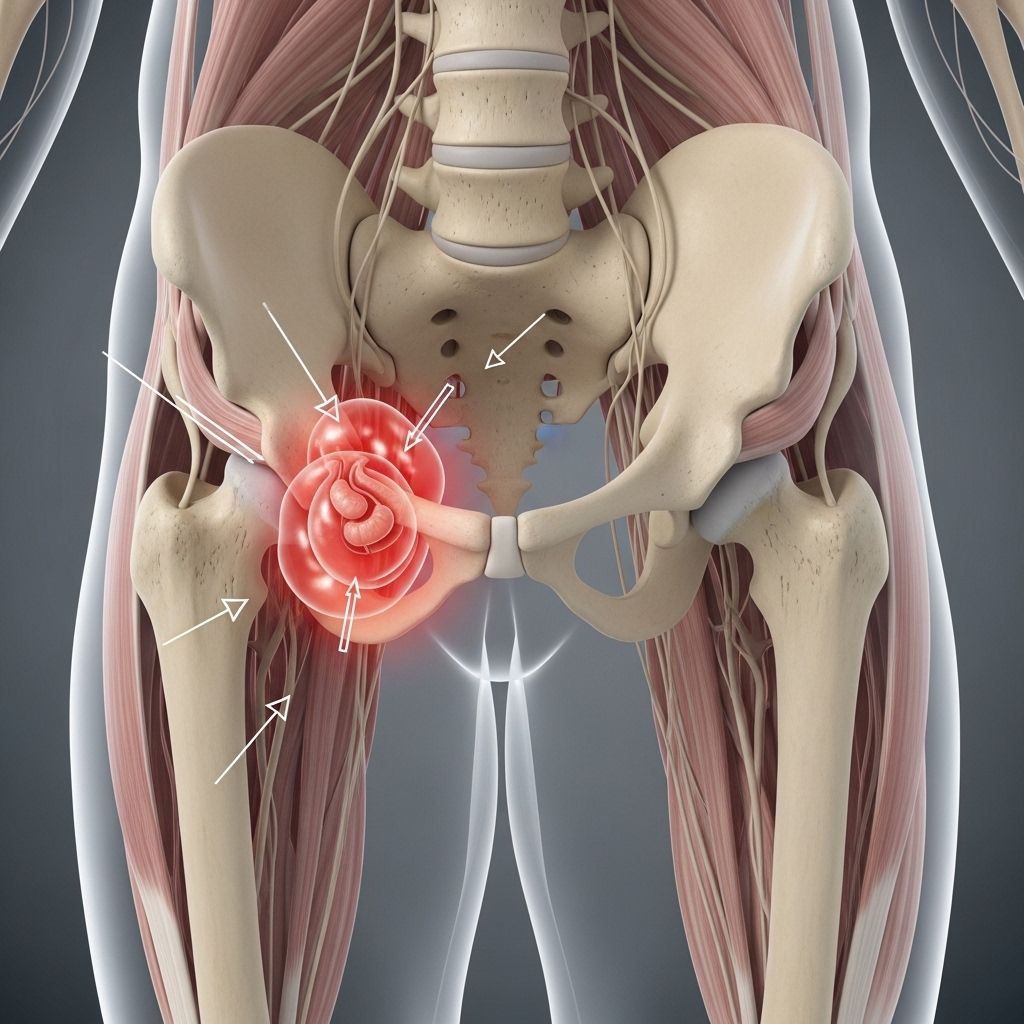Effective Home Remedies for Hip Bursitis: Relieve Pain Naturally
Posture tweaks and mindful exercises combine to ease tension and restore smooth movement.

Effective Home Remedies for Hip Bursitis
Hip bursitis is a common yet painful condition caused by the inflammation of the bursa — small, fluid-filled sacs that cushion your joints and reduce friction between tissues. Most frequently affecting the outside of the hip, hip bursitis can lead to sharp pain, swelling, and limited mobility. While medical treatment may be necessary for severe cases, many people experience relief using thoughtful lifestyle changes, targeted exercises, and home therapies. This comprehensive guide explores the most effective natural remedies and supportive protocols to help you manage hip bursitis and restore comfort to your hips.
What Is Hip Bursitis?
Bursitis refers to the inflammation of bursae, which are small structures that act as cushions between bones and soft tissues. There are several bursae around the hip, but the trochanteric bursa is most often affected. Hip bursitis typically develops due to repetitive movements, excessive pressure, direct trauma, poor posture, or underlying medical conditions such as arthritis.
- Common Symptoms:
- Sharp or aching pain on the outside of the hip
- Swelling or tenderness near the affected area
- Pain worsening with movement, climbing stairs, or lying on one side
- Stiffness and reduced ability to move the hip
Main Causes of Hip Bursitis
Understanding the triggers of hip bursitis can help you take preventive measures and tailor your home care strategies.
- Repetitive stress from activities such as running or cycling
- Prolonged standing, walking, or sitting on hard surfaces
- Trauma or direct blows to the hip
- Poor biomechanics or posture issues
- Underlying health conditions — e.g., rheumatoid arthritis, gout
- Muscle weakness or imbalance around the hip
9 Effective Home Remedies to Relieve Hip Bursitis Pain
While medication may play a role in managing hip bursitis, several home remedies can be just as effective in easing your symptoms and supporting recovery.
1. Rest and Activity Modification
Avoiding activities that aggravate your pain, such as repetitive movements or prolonged pressure on the hip, is the first step to help your bursa heal.
Tips for rest:
- Temporarily reduce physical activities that irritate the hip, like running or jumping.
- When sleeping, lie on your back or uninjured side and use a supportive pillow between your knees to reduce hip stress.
- Resume gentle exercises only when pain subsides.
2. Cold Compresses
Applying ice packs to the affected area can help reduce swelling and numb pain by constricting blood vessels and limiting inflammation.
- Wrap an ice pack or bag of frozen vegetables in a towel.
- Apply to the side of the hip for 15–20 minutes at a time, multiple times daily.
- Always allow the skin to warm naturally between applications.
3. Heat Therapy
Once initial inflammation has decreased, gentle heat can soothe chronic pain and relax tense muscles.
- Use a warm towel, heating pad, or a hot water bottle.
- Apply for 20 minutes to the hip area, but avoid excessive heat exposure or using heat on fresh swelling.
- Alternate between heat and cold therapy as needed.
4. Gentle Hip Stretches and Strengthening Exercises
A structured exercise routine supports healing by improving hip flexibility, strength, and alignment. Always consult with a physiotherapist before starting any exercise regimen, especially with significant pain.
- Prone Hip Extension: Lie face down, bend one knee at a 90-degree angle, and gently lift your thigh off the ground. Repeat 10–15 times per side. Focus on activating the glute muscles.
- Bent Knee Fallouts: While lying on your back with knees bent, lower one knee gently outward, keeping hips stable. Alternate sides.
- Sidelying Hip Abduction: Lie on your side, raise the top (straight) leg upwards, pause, and lower. Repeat 10–15 times.
- Supine Hip Abduction: Lying flat on your back, move one leg outward. Keep your back and hips stable. Repeat for each leg.
- Hooklying Straight Leg Raise: With one knee bent and the other leg straight, lift the straight leg upward and lower slowly.
- Dead Bug: On your back, flex hips and knees, and alternately raise one arm and the opposite knee up. Repeat with control.
For best results, perform these exercises daily, focusing on gentle movement and proper technique.
5. Over-the-Counter Pain Relief (Use With Caution)
Nonsteroidal anti-inflammatory drugs (NSAIDs), such as ibuprofen or naproxen, can temporarily relieve pain and reduce swelling. However, always use them according to label instructions and as a supplement to non-drug therapies.
6. Anti-Inflammatory Diet and Herbal Supplements
Eating a diet rich in anti-inflammatory foods and nutrients may support bodily healing and reduce the frequency of flare-ups.
- Omega-3 Fatty Acids: Found in fish oil, flaxseed, walnuts; help decrease joint inflammation.
- Turmeric and Ginger: Their active compounds (curcumin in turmeric, gingerol in ginger) have natural anti-inflammatory properties.
- Bromelain: An enzyme in pineapple, often recommended for swelling and soft tissue injuries.
- Glucosamine and Chondroitin: May promote joint health, though evidence is not robust.
- Consider herbal teas (e.g., white willow, Boswellia) — but discuss with your doctor before use as direct evidence for bursitis is limited.
Be cautious with supplements, as some may interact with medications or cause allergic reactions.
7. Massage and Compression
Gentle massage around the hip may improve circulation and help reduce discomfort, but avoid massaging directly over swollen bursae.
- Use gentle, circular motions with a lubricant like coconut oil.
- Compression sleeves or wraps may help reduce swelling; do not apply too tightly.
8. Posture Correction and Movement Therapies
Correcting posture and retraining movement patterns are essential for both recovery and prevention of hip bursitis. Certain therapies and mindful practices are beneficial:
- Yoga and Pilates to improve flexibility and strengthen supporting muscles.
- Tai Chi or Feldenkrais Method for awareness of body movements and improved alignment.
- Physical therapy guidance for personalized exercises and gait correction.
9. Lifestyle Modifications
- Wear supportive, cushioned shoes.
- Avoid sitting or lying on hard surfaces for extended periods.
- Gradually reintroduce low-impact activities such as swimming or cycling as symptoms improve.
- Maintain a healthy body weight to reduce pressure on the hips.
- Consider using assistive devices (cane, crutches) temporarily to offload weight and provide stability.
When to Seek Medical Attention
While most cases of hip bursitis improve with home care, you should consult a healthcare professional if:
- Pain is severe, constant, or worsening
- There is obvious swelling, redness, or heat around the hip
- Symptoms do not improve after several weeks of self-care
- You experience fever or other signs of infection
In some cases, corticosteroid injections, physical therapy, or even minor procedures may be needed to resolve persistent bursitis.
FAQs: Hip Bursitis Home Care
Q: Can hip bursitis resolve on its own?
A: Mild cases of hip bursitis often improve with rest, ice, physical therapy exercises, and activity modification over days to weeks. Chronic or severe bursitis may require professional evaluation and treatment.
Q: What exercises should I avoid with hip bursitis?
A: Avoid repetitive high-impact activities (running, jumping), deep squats, leg lifts with resistance, and any movement that causes sharp pain in the hip.
Q: Is it safe to massage over the inflamed area?
A: It is best to massage around the hip without applying direct pressure over the swollen or painful bursa to prevent additional irritation.
Q: Are supplements like fish oil and turmeric effective?
A: Omega-3 fatty acids and turmeric are commonly used to help reduce inflammation, but scientific evidence for their effect on bursitis is limited. Always consult a healthcare provider before starting new supplements.
Q: How long does it take for hip bursitis to heal?
A: Most cases improve within 2–8 weeks with proper home care, though chronic conditions may persist longer and require additional treatment.
Summary Table: Home Remedies for Hip Bursitis
| Remedy | Benefit | Precautions |
|---|---|---|
| Rest & Activity Modification | Reduces aggravation and promotes healing | Avoid inactivity; gentle movement is helpful |
| Cold Compresses | Reduces swelling, provides pain relief | Limit to 20 mins per session; avoid direct skin contact |
| Heat Therapy | Relaxes muscles, eases chronic pain | Use only after swelling subsides |
| Anti-Inflammatory Diet | Lowers systemic inflammation | Consult with physician if taking supplements |
| Physical Therapy Exercises | Strengthens muscles, improves mobility | Start slow; discontinue if pain worsens |
| Massage & Compression | Improves circulation, reduces discomfort | Avoid pressing directly on the bursa |
| Posture Correction | Prevents recurrence, improves joint alignment | Professional assessment for best results |
Additional Tips for Lasting Relief
- Track your pain and triggers in a journal to identify behavioral patterns or aggravating activities.
- Wear loose, comfortable clothing to avoid extra pressure on the hip.
- Consider ergonomic adjustments to your workspace or seating.
- Stay hydrated and maintain a balanced electrolyte intake.
Conclusion
Hip bursitis can disrupt daily life, but a thoughtful self-care regimen focused on rest, gentle movement, and anti-inflammatory strategies offers significant relief. If home therapies do not resolve your symptoms or if you experience exacerbation, consult with a healthcare specialist to explore additional interventions. Remember, patience and consistent care are essential for recovery — embracing these remedies helps you regain comfort and mobility, naturally.
Frequently Asked Questions (FAQs)
Q: Can hip bursitis return?
A: Yes, especially if the underlying causes (repetitive motion, poor posture, muscle imbalance) are not addressed. Maintaining stretches, strengthening, and good habits helps lower recurrence risk.
Q: Are home exercises safe for everyone?
A: Most gentle exercises and stretches are safe, but if you have severe pain, history of hip surgery, or other medical concerns, get guidance from a physical therapist before starting a new routine.
Q: What medical treatments are available if home remedies fail?
A: Common medical treatments include corticosteroid injections, professional physical therapy, and in rare cases, surgical intervention to remove the inflamed bursa.
References
- https://www.ebsco.com/research-starters/complementary-and-alternative-medicine/natural-treatments-bursitis
- https://www.bswhealth.com/blog/hip-pain-hip-bursitis-exercises-to-try-at-home
- https://www.youtube.com/watch?v=xqPew4-Pq54
- https://www.palmettoboneandjoint.com/blog/9-self-care-tips-for-people-with-bursitis/
- https://myhealth.alberta.ca/Health/aftercareinformation/pages/conditions.aspx?hwid=uh3444
- https://my.clevelandclinic.org/health/diseases/4964-trochanteric-bursitis
- https://www.drscotthompson.com/5-ways-to-naturally-heal-hip-bursitis/
- https://www.nhs.uk/conditions/bursitis/
- https://www.youtube.com/watch?v=FLwpXJN2GC4&vl=en
Read full bio of Sneha Tete









